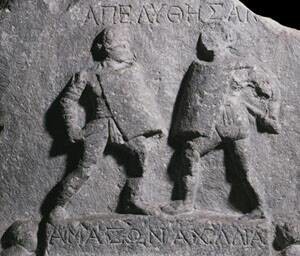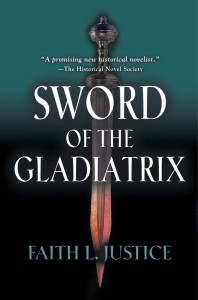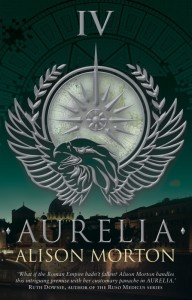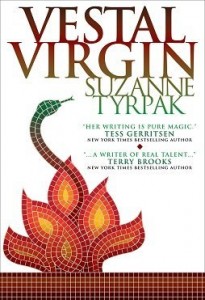 Relevant History welcomes Faith L. Justice, who writes award-winning fiction and articles in Brooklyn, New York. Her work appeared in such publications as Salon.com, Writer’s Digest, and The Copperfield Review. She is a frequent contributor to Strange Horizons and Associate Editor for Space and Time Magazine. For fun, she likes to dig in the dirt—her garden and various archaeological sites. To learn more about Faith’s books, check out her web site and blog. Follow her on Facebook, Twitter, and Goodreads.
Relevant History welcomes Faith L. Justice, who writes award-winning fiction and articles in Brooklyn, New York. Her work appeared in such publications as Salon.com, Writer’s Digest, and The Copperfield Review. She is a frequent contributor to Strange Horizons and Associate Editor for Space and Time Magazine. For fun, she likes to dig in the dirt—her garden and various archaeological sites. To learn more about Faith’s books, check out her web site and blog. Follow her on Facebook, Twitter, and Goodreads.
*****
Yes, really! Whenever I pitched Sword of the Gladiatrix as my “lesbian gladiator novel,” I encountered raised eyebrows and skeptical snorts. The first question everyone asked: “Were there really lesbian gladiators?” My answer: “Of course!” We know there were female gladiators fighting in arenas for several centuries. Some had to be lesbian.
What really surprised people was the fact of female gladiators. They rarely appear in popular culture. Despite the popularity of “Xena Warrior Princess” and the myths of the Amazons, female gladiators don’t come to mind in the media-soaked imaginings of brutal, bloody, gladiatorial games. Women warriors? Maybe. Women gladiators? No. Yet they are there in grave markers, classical literature, laws, and art. All you have to do is look.
The Writers
One organizer in Ostia brags on his tombstone that he was the first person to put women in the arena as fighters. Tacitus in his Annals mentions that Emperor Nero regularly had female gladiators in his shows. Suetonius tells us in his Life of Domitian that the Emperor once staged a performance at night where women fought other women by torchlight. Martial in his description of the entertainments in the Flavian Arena (the Coliseum) compared the women’s feats to those of Hercules.
These women fighters weren’t all captives, slaves, or from the lower classes. Juvenal in his Satires mocks women from the senatorial class who chose to join the gladiatorial ranks: “…and look how their little heads strain under such weighty helmets and how thick bandages of coarse bark support their knees.” Dio Cassius wrote of Nero, “There was another exhibition that was at once most disgraceful and most shocking, when men and women not only of the equestrian but even of the senatorial order appeared as performers in the orchestra, in the Circus, and in the hunting-theatre, like those who are held in lowest esteem…they drove horses, killed wild beasts, and fought as gladiators, some willingly and some sore against their will.”
The Lawyers
Some of the strongest evidence we have of female gladiators is in the law—recruiting and fighting women was banned, not once, not twice, but three times! Augustus, the first emperor, implemented lots of laws restricting women. Among them, in AD 11, he decreed that freeborn females under the age of twenty were forbidden from appearing on the stage or in the arena. In AD 19, he extended that to prohibit “gladiatorial recruitment of daughters, granddaughters, and great-granddaughters of senators or of knights, under the age of twenty.” In 200, Emperor Septimus Severus banned single combat by women in the arena because of “recrudescence among some upper-class women, and the raillery this provoked among the audience.” These prohibitions probably made the fights all the more popular, human nature being what it is.
The Artists
 Although we have no mosaics showing female gladiators, we do have a couple of art depictions: a bronze statue of a woman in gladiatorial dress and a stone relief found in Halicarnassus (modern Bodrum, Turkey) showing two women equipped as gladiators and fighting without helmets. The Greek inscription on the stone relief says Amazon and Achillia (obviously stage names) fought bravely. I saw this piece in the British Museum and the image of those two women haunted me. They were real women who lived and died centuries ago. Who were they? Where did they come from? How did they feel about their lives? That’s when I decided to tell their story. Well, not their story—no one knows their background or fates. I had to create my own characters.
Although we have no mosaics showing female gladiators, we do have a couple of art depictions: a bronze statue of a woman in gladiatorial dress and a stone relief found in Halicarnassus (modern Bodrum, Turkey) showing two women equipped as gladiators and fighting without helmets. The Greek inscription on the stone relief says Amazon and Achillia (obviously stage names) fought bravely. I saw this piece in the British Museum and the image of those two women haunted me. They were real women who lived and died centuries ago. Who were they? Where did they come from? How did they feel about their lives? That’s when I decided to tell their story. Well, not their story—no one knows their background or fates. I had to create my own characters.
One of the non-fiction authors I consulted felt Nero encouraged the expansion of women in the games, so I looked closely at his reign and found two remarkable events that happened, in the same time frame, at opposite ends of the Empire: an expedition to Kush and the British revolt. Both involved cultures where women were valued as more equal partners in life and government than in Rome, and both had powerful queens who defied Roman power—one unsuccessfully in battle, one successfully with guile. These cultures provided plausibly strong (both in body and character) female protagonists. I created Afra and Cinnia to stand in for those two women carved on the stone. I hope you enjoy their story in Sword of the Gladiatrix.
*****
 A big thanks to Faith Justice. She’ll give away a copy of Sword of the Gladiatrix to someone who contributes a comment on my blog this week. I’ll choose the winner from among those who comment by Friday at 6 p.m. ET. Delivery is available worldwide. (A winner in the US or Canada may choose between an ebook or trade paperback.)
A big thanks to Faith Justice. She’ll give away a copy of Sword of the Gladiatrix to someone who contributes a comment on my blog this week. I’ll choose the winner from among those who comment by Friday at 6 p.m. ET. Delivery is available worldwide. (A winner in the US or Canada may choose between an ebook or trade paperback.)
**********
Did you like what you read? Learn about downloads, discounts, and special offers from Relevant History authors and Suzanne Adair. Subscribe to Suzanne’s free newsletter.








